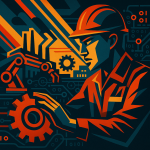Key Points
- The Beijing Shijingshan (Shíjíngshān 石景山) robot training ground has become a global player, with OpenAI and Google procuring cross-border data from the facility.
- Opened in March 2025, the facility is described as China’s first integrated robot training center combining data collection, scenario training, and industrial collaboration.
- Embodied AI training grounds act as innovation testbeds, practical training centers, accelerators for scenario applications, and “super factories” for high-quality data.
- China currently has no more than 10 embodied intelligent training grounds built, with plans to grow to 20-30 soon, and a broader “Ten-Hundred-Thousand” project aiming for 10 international, 100 regional, and 1,000 industry-specific training grounds within three years.
Beijing Shijingshan robot training ground is now a named player in global embodied AI data supply chains.
OpenAI and Google have procured data linked to the Beijing Shijingshan (Shíjíngshān 石景山) robot training ground, according to remarks made during a “Digital Government” exchange at the 2025 China International Big Data Industry Expo.
This article explains what happened, why it matters for embodied AI and robotics, and what investors, founders, and product teams should watch next.
What was announced: cross-border data procurement
On August 27, an individual from the China Information Association disclosed that “some data from the Beijing Shijingshan (Shíjíngshān 石景山) robot training ground has been involved in cross-border transactions, with both OpenAI and Google procuring data from the Shijingshan training ground.”
The Beijing Shijingshan Humanoid Robot Data Training Center officially opened in March 2025 as part of the second phase of the Shougang Park (Shǒugāng Yuán 首钢园) Sci-Fi Industrial Cluster in Shijingshan District.
The facility is described as the first integrated robot training center in China that combines data collection, scenario training, and industrial collaboration.

Global context: embodied AI robot training grounds
The same source outlined the broader international landscape for embodied robotics training facilities.
In the United States, intelligent robot training grounds are distributed across multiple locations, with core hubs covering at least 10 states and expansion still underway.
Amazon plans to establish eight robot centers in Florida, reflecting rapid development in embodied robotics in the U.S.
South Korea operates at least three embodied robot training grounds: the Daegu National Test Site, the Seoul Suseo (Suixī 水西) Park, and the Mech-Mind (Meikamande 梅卡曼德) Training Center.

Find Top Talent on China's Leading Networks
- Post Across China's Job Sites from $299 / role
- Qualified Applicant Bundles
- One Central Candidate Hub
Your First Job Post Use Checkout Code 'Fresh20'

China’s embodied AI infrastructure: current build and short-term plans
In China, the source said that institutions have set up an embodied intelligent robot training ground in Beijing’s Shijingshan district.
Similar facilities have been constructed in Shunde (Shùndé 顺德), Foshan (Fóshān 佛山).
The current estimate is no more than 10 embodied intelligent training grounds built in China, with expectations that the number will grow to 20–30 as construction accelerates.
The Shijingshan robot training ground supports domestic applications and also participates in cross-border data transactions.
Why training grounds matter
Embodied intelligent training grounds are being framed as crucial infrastructure for the AI industry.
They act as:
- Innovation testbeds where real-world scenarios meet algorithmic development.
- Practical training centers for talent learning embodied systems and human-robot collaboration.
- Accelerators for scenario applications that reduce the time between lab demo and industrial deployment.
- “Super factories” for high-quality data that feed perception and control models used in commercial robots.
Functional roles summarized
The training grounds were summarized with four core functions:
- Achieving closed-loop data collection.
- Conducting training in real physical environments.
- Promoting human-machine collaboration and evaluation.
- Facilitating technology transfer and generalization.
These facilities are intended to help address the “last mile” problem in robot scenario applications and to accelerate the transformation and upgrading of traditional industries.
- 10 international training grounds
- 100 regional training grounds
- 1,000 industry-specific training grounds
China’s “Ten-Hundred-Thousand” project
China plans a “Ten-Hundred-Thousand” project aimed at building:
- 10 international training grounds,
- 100 regional training grounds, and
- 1,000 industry-specific training grounds
The goal is to roll this out over the next three years to bolster embodied AI infrastructure across scales.
Heterogeneous robot designs and scenario diversity
The training grounds will include a diverse range of robot body designs.
Examples include single-arm and dual-arm operations, mobile forms, wheeled robots, and dual-axis robots, demonstrating a high degree of heterogeneity in physical platforms.
That heterogeneity is important because varied hardware enables richer data, better generalization of models, and more robust transfer to industry-specific tasks.

ExpatInvest China
Grow Your RMB in China:
- Invest Your RMB Locally
- Buy & Sell Online in CN¥
- No Lock-In Periods
- English Service & Data
- Start with Only ¥1,000

Key takeaways for investors, founders, and technologists
Cross-border data flows matter.
When major AI companies procure data from facilities like the Beijing Shijingshan robot training ground, they are buying access to curated, scenario-specific embodied datasets that are expensive and time-consuming to generate in-house.
Training grounds reduce deployment risk.
Real-world closed-loop training accelerates the pathway from prototype to commercial product, which is attractive to investors and corporate adopters.
Partnership opportunities are rising.
Founders building robot hardware, perception stacks, simulation systems, or domain-specific data pipelines should consider collaboration and licensing models with these centers.
Policy and compliance will be a live conversation.
Cross-border data transactions and international procurement introduce regulatory and governance considerations that product teams and legal counsel must monitor closely.

Resume Captain
Your AI Career Toolkit:
- AI Resume Optimization
- Custom Cover Letters
- LinkedIn Profile Boost
- Interview Question Prep
- Salary Negotiation Agent


Linking and SEO opportunities
This story creates natural anchor opportunities for content about:
- Embodied AI and robotics infrastructure.
- Robot training datasets and cross-border data procurement.
- Shijingshan district industrial clusters and Shougang Park’s Sci-Fi Industrial Cluster.
- OpenAI and Google as enterprise data consumers.
Use anchor text such as “robot training ground data” or “embodied AI testbeds” when linking to deeper analyses, whitepapers, and partner pages.

What to watch next
Track the rollout of China’s “Ten-Hundred-Thousand” project and announcements about new training ground openings.
Monitor corporate and academic partnerships tied to facilities in Shijingshan, Shunde, and Foshan to understand where high-quality embodied datasets are being created.
Keep an eye on policy discussions around cross-border AI data transfers as procurement activity from global companies increases.

Bottom line
Beijing Shijingshan robot training ground has moved from a domestic infrastructure story to a node in the global embodied AI data market, with OpenAI and Google named as data procurers.
References
- OpenAI采购北京石景山机器人训练场跨境数据 | 数博会 – 中国经营报
- 北京市石景山区人民政府 – 关于《石景山区促进机器人产业发展若干措施 (征求意见稿)》面向社会公开征集意见的公告
- OpenAI Official Website
- Google Official Website
Beijing Shijingshan robot training ground





